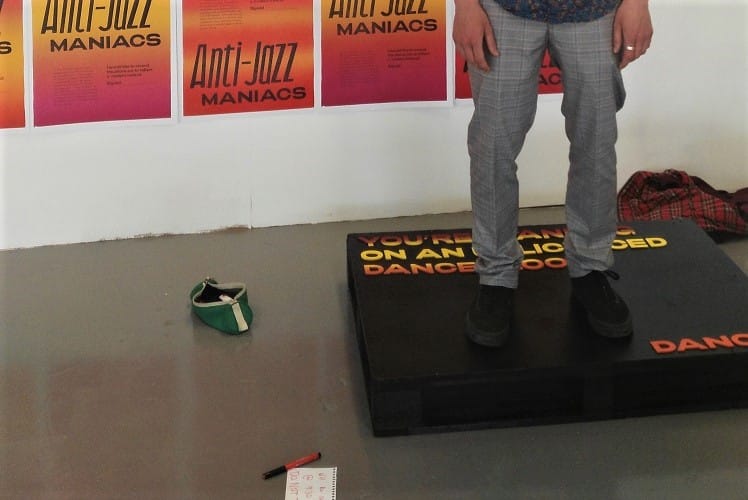What would become of the Civic Offices on Wood Quay if the council relocates?
After The Currency reported the idea of the council moving its HQ, councillors were talking about and thinking through the pros and cons and implications.
Lorcan Rush wheeled a dance floor around Dublin, breaking the law everywhere from Merrion Square to in front of the Dáil, as his project for the NCAD graduate exhibition, set to run 9–17 June.

You never know what you’re going to find lying around the National College of Art and Design, says Lorcan Rush, a final-year design student.
It’s one of the best things about the place. “It’s a bit like Hogwarts in a sense. Things just appear when you need them,” he says.
Like the dolly cart he stumbled across when he needed a way to transport his illegal portable dance booth around Dublin.
In an open-plan studio on Thursday, some students were hunched over desks and chatting as they finalised their projects for the NCAD graduate exhibition, which is scheduled to run from 9 to 17 June.
Near the back, much of the wall around Rush’s project is postered, and a glossy black platform rests on the floor. There are pencil cases, pens, Post-its and the debris of a work in progress around it.
“You’re standing on an unlicensed dancefloor,” it says on the platform, in Rush’s custom typeface. “Dance.”
The platform is a slicker incarnation of the slightly rickety dance space that Rush took on a trip around the city a few weeks ago.
His exhibit also includes a book he put together on controversial nightclub flyers from the 1970s and ’80s.
“As you can probably tell from the project, I enjoy going out. I dabble in DJing, just as a hobby,” he says. For Lent, he tasked himself with going to at least one live music show a week.
After writing his thesis on branding and visual identity in Dublin nightlife, Rush says he knew he wanted to continue in the same vein for his degree project.
Through his research, and an event with the group Give Us the Night, he learned about the Public Dance Halls Act. Still in effect, the act has shaped Dublin nightlife since 1935.
It means that it’s illegal to have a designated dancing place, “which is open to the public and in which persons present are entitled to participate actively” without a licence.
By place, it means “a building (including part of a building), yard, garden, or other enclosed place, whether roofed or not roofed and whether the enclosure and the roofing (if any) are permanent or temporary”.
Rush was interested in what the act meant by “place”, and by public participation. At first, he wanted to design something to try to get around the act.
“Is there a dance space that I can design that is a loophole to the act?” asks Rush. Maybe by making it mobile, or finding a way for people to be participate but not “actively”?
He changed tack, though. “I thought it was better to actually break all the rules rather than to try and find a loophole to highlight its stupidity, so that was what I did then,” he says.
Rush heard about the act at a meeting with one of his favourite techno DJs, Sunil Sharpe, who helped set up the group Give Us the Night in 2004.
“It’s antiquated legislation now,” says Sharpe, who continues to press for a change to the law. “It isn’t relevant anymore.”

Rush built his booth over about two days out of a wooden pallet, and rolled it around Dublin, from Merrion Square to Trinity College – ending his stunt outside the Dáil – while a friend recorded the journey.
The booth had been thrown together fast. “In the video you can actually see it wobbling, which I think is really funny, which just goes to show how unlicensed of a dance space it is,” he says.
Rush didn’t want to just rock up and start to dance, in case people just thought he was crazy. So, he added an explainer panel as a backdrop to highlight the act and explain his case for abolishing it.
He danced to a playlist off his phone. “I was really nervous,” he says. “When I got up first, I was like a bread-stick; I was very rigid.”
After a while the nerves wore off, he says. “And it was just like, you knew you had to do this, you knew this was coming.”
The booth worked best in relaxed environments. People got up and danced with him and, as they danced, Rush explained the finer points of the booth and the legislation.
When he took the booth to the Dáil, the first thing the guard outside asked him was whether he had a permit, says Rush. He told him what the project was about.
“He said, just move it down a bit so I don’t see you. So I was a bit annoyed that I didn’t get fined,” Rush says, laughing.
The posters double up as petitions. Rush handed them out at nightclubs around town, with stamps on the back, so dancers could send them to their TDs.
Independents 4 Change TD Mick Wallace received one of the flyers. “I liked it so much I stuck it up on the wall of my office,” he says, by email.
“It is very strange that this Act is still in place, and I’m glad this is being highlighted in the NCAD grad show and that students are making political art,” says Wallace.
Says Rush: “I’ve never enjoyed doing my work as much as I have this … The dance booth is a really good idea, but it’s just the start.”
Now he has the video his friend recorded too, and sees it as the start of a campaign. “I’m really going to try and get this act amended now,” he says.